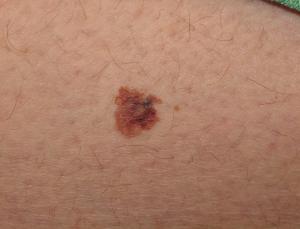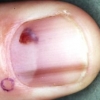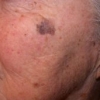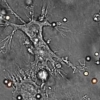Melanoma associato ad inibitori del TNFα
 Un progetto di ricerca sugli eventi avversi ai farmaci (RADAR).
Un progetto di ricerca sugli eventi avversi ai farmaci (RADAR).
Gli inibitori del fattore di necrosi tumorale alfa (TNFαIs) sono utilizzati per il trattamento dei disturbi infiammatori, ma ci sono alcune prove che collegano questi agenti con la comparsa delle neoplasie. Per quattro TNFαIs su cinque, la Food and Drug Administration (FDA) ha dichiarato sull'etichetta che "è stato riscontrato il melanoma nei pazienti trattati con questi farmaci".
Obiettivi
Determinare se esiste un'associazione statisticamente significativa tra la somministrazione di TNFαIs e lo sviluppo del melanoma maligno.
Metodi
Abbiamo fatto una ricerca all'interno del database “FDA Adverse Events Reporting System” (FAERS) per i termini correlati al melanoma e ai TNFαIs in modo da rilevare i segnali di sicurezza. Abbiamo cercato anche all'interno di un grande database accademico di cartelle cliniche (EMR) con il quale abbiamo calcolato il rischio relativo (RR) di melanoma nei soggetti esposti a TNFαIs rispetto ai soggetti non esposti.
Risultati
Ci sono state 972 segnalazioni di melanoma associate a un TNFαIs identificato nel database FAERS, con 69 report fra gli individui che utilizzavano più di un TNFαI. È stato rilevato un segnale di sicurezza per infliximab (I), golimumab (G), etanercept (E) e adalimumab (A). Per certolizumab pegol (CP) non è stato rintracciato alcun segnale di sicurezza. Per i TNFαIs come classe di farmaci è stato riscontrato un segnale di sicurezza nel database FAERS, mentre l'RR è stato significativo nel database delle EMR. Per la coorte di EMR, 6,045 pazienti sono stati esposti a TNFαIs e sono stati rilevati 35 casi di melanoma. È stato individuato un valore di RR per A (RR = 1.8, p = 0.02) e per E (RR 2.35, p = 0.0004).
Conclusioni
In due analisi diverse, abbiamo identificato una significativa associazione tra l'esposizione ai TNFαIs e il melanoma maligno. I nostri risultati si aggiungono alle prove già esistenti che correlavano questi agenti con l'insorgenza del melanoma maligno. Ad ogni modo sono necessarie ulteriori indagini per esplorare questa associazione e il rischio di melanoma a seguito di terapia con TNFαI.
Storia della pubblicazione:
Titolo: Melanoma Associated with TNFα Inhibitors: a Research on Adverse Drug events And Reports (RADAR) Project
Rivista: British Journal of Dermatology. doi: 10.1111/bjd.12779
Autori: B. Nardone, J.A. Hammel, D.W. Raisch, L.L. Weaver, D. Schneider, D.P. West
Affiliazioni:Department of Dermatology, Northwestern University College of Pharmacy, University of New Mexico Northwestern University Clinical and Translational Sciences (NUCATS) Institute, Northwestern University
Abstract:
Background Tumor necrosis factor-alpha inhibitors (TNFαIs) are used for treatment of inflammatory disorders. There is evidence linking these agents with occurrence of malignancies. For four out of five TNFαIs the Food and Drug Administration (FDA) label states, “melanoma has been reported in patients treated with these agents.” Objectives Determine whether a statistically-significant association exists between administration of TNFαIs and development of malignant melanoma. Methods We searched the FDA Adverse Events Reporting System (FAERS) database for terms related to melanoma and TNFαIs for detection of safety signals. We also searched a large urban academic electronic medical record (EMR) database for which we calculated the relative risk (RR) of melanoma in subjects exposed to TNFαIs vs. non- exposed subjects. Results There were 972 reports of melanoma associated with a TNFαIs identified in the FAERS database, with 69 reports among individuals using more than one TNFαI. A safety signal was detected for infliximab (I) golimumab (G), etanercept (E), and adalimumab (A). Cetrolizumab pegol (CP) had no detectible safety signal. For TNFαIs as a class of drugs, a safety signal was detectable in the FAERS database, and RR was significant in the EMR database. For the EMR cohort, 6,045 patients were exposed to TNFαIs and 35 cases of melanoma were detected. Significance for RR was detected for A (RR = 1.8, p = 0.02) and E (RR 2.35, p = 0.0004). Conclusions We identified a significant association between exposure to TNFαIs and malignant melanoma in two different analyses. Our findings add to existing evidence linking these agents with the occurrence of malignant melanoma. Additional investigations are required to further explore this association and the risk of melanoma with TNFαI therapy.




